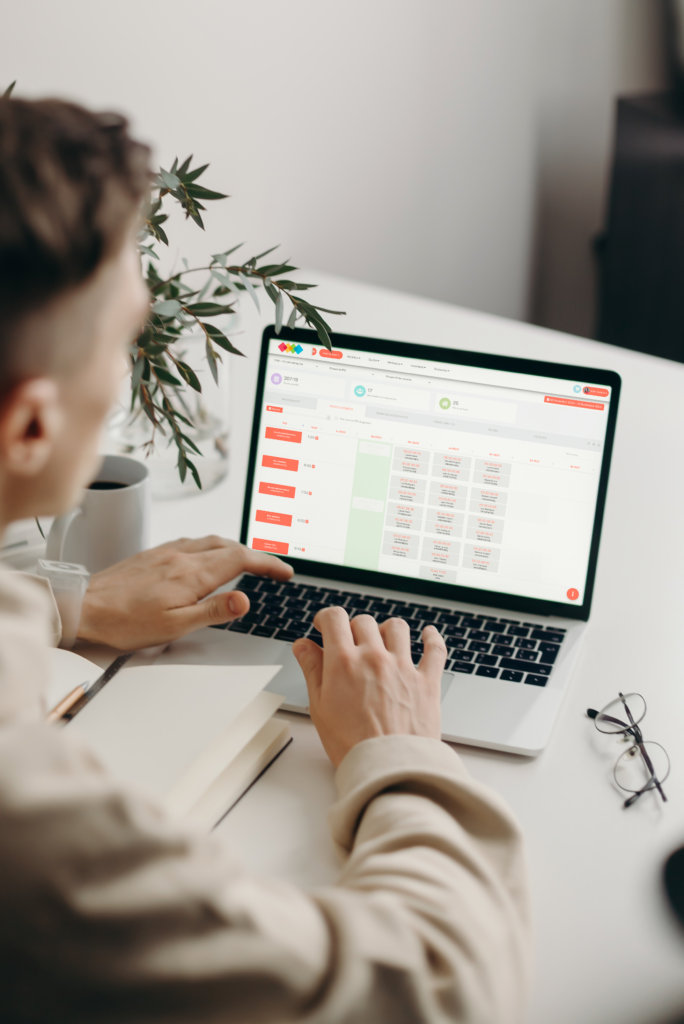To ensure a healthy environment in your company, implementing regular discussions with your employees is essential. From your office, it is challenging to have an eye on what is happening on the ground. Your agents are therefore in the best position to provide you with accurate information about the movements within your operation. But how do you gather this feedback? Through the implementation of briefings.
Briefings serve as effective means for discussing daily topics. Whether through formal or informal exchanges, these moments are goldmines for identifying areas of improvement. They help motivate teams and address daily issues with responsiveness. Discover our ultimate guide on best practices for conducting briefings in your company!
What is the purpose of a briefing ?
A briefing is a moment when team members come together to freely exchange ideas and discuss various topics : safety, hygiene, reported incidents, work environment, operational processes, and more. During these sessions, all employees participate ! Due to their short and quick format, they boost active and constructive participation from each of your team members. It’s the perfect opportunity to create an engaging and effective work environment where everyone learns from each other, shares innovative ideas, and develops their skills.
Facing challenges? Briefings help find solutions suited to any situations employees may encounter. They are also very useful for inspiring your team by celebrating successes and achieved goals.

What are the different situations where a briefing might be necessary ?
Briefings can be very helpful for managers and can be adapted to various situations. These moments of exchange and dialogue transform your team’s dynamics and significantly improve efficiency and engagement at work. Here are some examples of situations where briefings can make a big difference:
- Daily Briefing : Allows for discussion on ongoing projects, customer requests, goals to be achieved, or challenges to be overcome.
- Safety Briefing : Helps identify safety shortcomings and raises awareness among your teams about safety practices, emergency procedures, and workplace health standards.
- Debriefing after a project or event : Allows for evaluating performance, identifying strengths and areas for improvement, and sharing lessons learned.
- Brainstorming session : Enables the generation of new and creative ideas on a specific problem or challenge.
- Training briefing : Provides information and practical advice on new policies, procedures, or technologies.
- Problem-solving meeting : Discusses pending operational or human issues and collaborates on effective solutions.
The consequences of a poorly prepared briefing
On the other hand, poor preparation of a briefing can produce effects completely contrary to those intended. The consequences will be felt in the quality of the discussions, the motivation of the participants, and the overall effectiveness of the session. Your team members may lose the willingness to share their information, and this poor management could even affect the dynamism of your teams in their daily work.
A poorly prepared briefing can lead to detrimental repercussions such as:
- Loss of time and energy : Team members may feel frustrated and disinterested if the briefing lacks structure or clear objectives. This leads to a waste of time and energy, as discussions might drift into irrelevant topics or remain superficial without achieving the desired results.
- Decrease in motivation and engagement : If participants perceive the meeting as poorly organized or feel that their contributions are not valued, they may lose their engagement and not participate actively in the discussions.
- Poor decision-making : Decisions may be made based on incomplete or incorrect information, leading to negative consequences for the projects discussed during the briefing.
- Impact on credibility and trust : If participants perceive that the organizers of the briefing are not well-prepared, it can affect their credibility and ability to lead future discussions effectively. Their trust in the management may also be compromised.
What are the steps to prepare a briefing ?
To ensure a briefing is as effective as possible, thorough preparation is essential. Since the briefing leads to crucial decisions for the internal development of the company, preparation is necessary to optimize these discussions.
Below are the steps to follow for an ideal briefing:
1- Choose a relevant topic
Choosing the topic for your briefings is crucial: training on safety protocols, new equipment, changes in operational processes, etc. It not only sets the tone for the discussion but also influences your team’s engagement and interest. A well-chosen topic should be both relevant and engaging to ensure the success of the meeting.

A well-chosen topic ensures that the discussion addresses important issues for your team. It helps maximize the value of the exchanged information by focusing on subjects that have a direct impact on daily work or the company’s strategic objectives. The more engaging the topic, the more you encourage active participation from your team members.
On the other hand, a poorly thought-out topic can undermine the credibility of the session. If the theme does not align with the participants’ concerns or interests, it may make the briefing less productive and reduce your team’s enthusiasm.

2- Define clear objectives
Next, defining clear objectives for your briefings is very important for several reasons.
Well-defined objectives provide a clear direction for the discussion and help set the timing for the exchange. By clearly identifying what you aim to accomplish during the briefing, you guide both the content and flow of the discussion, and ensure that each participant knows what is expected of them.
This also facilitates the evaluation of the briefing’s success. You can measure whether the discussions achieved the desired outcomes, whether it’s solving a specific problem, making a collective decision, generating new ideas, or simply sharing crucial information.
When each of your team members understands the overall objective of the briefing and sees how their participation contributes to achieving it, they become actively engaged in the discussion.
3- Prepare a discussion plan
To ensure orderly and effective discussions during your briefings, it is essential to prepare a detailed plan in advance. This involves carefully listing the main points you want to cover and organizing them in a coherent manner.
- Organize the points in a logical order : Start with the most important topics and then smoothly progress to more specific details or concrete examples.
- Plan each stage of the briefing : This helps avoid going off track or getting lost in discussions. A detailed plan serves as a guide to keep you on course and within the allocated time.
A well-prepared plan ensures that all important topics are addressed. By following these steps, you create a structured environment for your briefings, fostering clear discussion. This allows all your team members to make the most of the session and achieve the set objectives together.
4- Use visual aids
To ensure your briefings remain memorable for your team, using visual aids is an invaluable asset. They help illustrate your points visually, capturing the attention and engagement of the participants. Incorporating concrete case studies, relevant anecdotes, practical demonstrations, and even videos enriches your presentation and makes the discussions more dynamic.
This creates a stimulating environment where information is not only heard but also seen. It promotes better information retention and encourages constructive discussions, making your briefings more impactful for your team.
Pour une causerie efficace, impliquez vos collaborateurs
To maximize the impact of a briefing, it is essential that each member of your team speaks up and shares their opinion on the topic. Their involvement and motivation to advance the discussion are crucial. Active participation from everyone is indispensable! To achieve this, the discussion leader must use techniques that encourage everyone, including the more reserved individuals, to contribute.

A piece of advice : Asking open-ended questions will help you gather a maximum amount of responses.
The timing of your briefing, best practices

The timing of your meetings deserves special attention. To maintain your team’s engagement, it is essential that the sessions are neither too long nor too short or rushed. Finding a balance where discussion can fully develop without draining energy and enthusiasm is crucial.
Establishing a structured agenda with a time limit for each briefing is fundamental. This helps keep the discussion on track and ensures a clear thread throughout the meeting. In this way, your team’s engagement is sustained, and you avoid extended discussions that could distract their attention. Scheduling breaks allows participants to recharge, reflect on the points discussed, and return with a refreshed mindset!
Collecting feedback after the briefing
After each briefing, collecting feedback is essential. It helps assess what was done well, what didn’t work, and what needs to be adjusted for future sessions.
Gather feedback from your team members! They are directly involved in the process and can provide very valuable insights. For example: Were the objectives of the briefing clear to them? Was the content of the discussion up to their expectations? Was the duration of the briefing appropriate? How do they assess the quality of the information gathered? Would they be interested in another session? What changes would they suggest?
This feedback enhances transparency and trust within the team, demonstrating that their contributions are valued and that continuous improvement is a priority.
MoveWORK, the essential assistant for your briefings
The MoveWORK ecosystem includes mobile applications designed for your team members and a modular, cross-functional platform, MoveWORK Flow, ideal for your meetings. It becomes essential for you before, during, and after your briefings!
Mobile applications, valuable assets for your briefings
Did a shelf nearly fall on one of your team members? Did another almost trip over tangled electrical cords? Did an employee slip due to a water leak? All these situations need to be addressed quickly to prevent them from happening again. With the myMissions app, your team members can directly report any hazardous situations encountered during their tasks via their mobile devices. This information is then sent to your managers through myDecisions, who can react instantly and later discuss the issues during your daily briefings.
Together, you can make all the necessary changes to eliminate the risks associated with these situations.
Dashboards to go further
Pair the MoveWORK Flow platform with your applications to centralize all the information collected by your team on a single platform. Thanks to its many features, the platform transforms your data into dashboards that you can use during your briefings. Within seconds, you will have a comprehensive view of the incidents reported in your area. For example, if your team members report several hazardous situations during an intervention, it could indicate a staffing shortage at that position. MoveWORK Flow helps you identify bottlenecks and adjust intervention processes accordingly.

